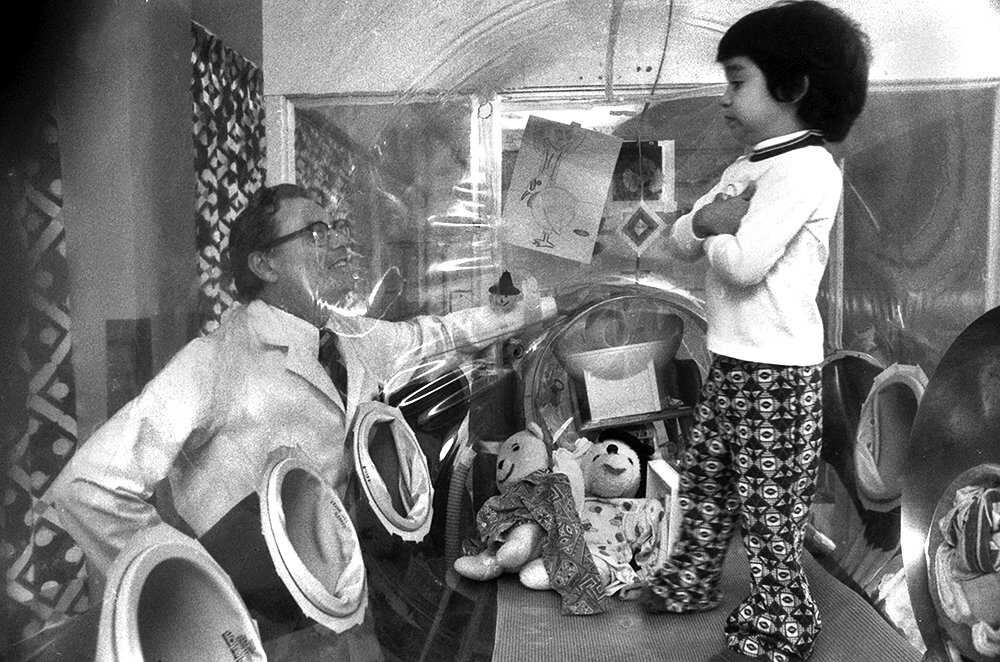David
Vetter is probably the most famous child in Texas around 1970-1980. The boy who
also known as “The Bubble Boy.” The reason for that was because he lived. He
lived with a critical condition known as severe combined immunodeficiency, or
SCID. Basically what it does is, it disables the patient’s immune system. Yes,
he didn’t have the immunity to fight even the most common germs in the air. So
how he lived? Inside a PVC bubble that specially designed for him by NASA.
Because
David’s elder brother died at 7 months old with the same genetic syndrome, doctors
were aware it could happen again. Once they found out David’s gender, they also
found that he is going to be born with SCID. Only male babies were affected by
this. Though females can be carriers. Since his parents asked doctors to make
him live, they started doing everything they can to save the baby. For starters
they immediately put the baby in isolation once he was born in Sept. 21, 1971.

[Putting baby David into the isolator]
David’s
first isolator was a 3-by-6-feet PVC bubble. It was literally a ‘baby bubble.’
But as he grew up the bubble had to expand too. Later it included four sections
including a playroom that size of 10-by-8-feet.

[Three-year-old David standing in his
supply isolator]
Everything
he had inside his bubble had to be sterilized. Even food. His father made
weekly trips to TCH to pick up sterilized items, like books, toys, clothes kind
of stuff. Everything was sealed inside cylinders and delivered to David through
a transport tunnel in his ‘bubble.’ As for food, he could only eat jarred baby
food since they were already sterile and sealed.
Despite
him being isolated, his family didn’t let him feel left out. "I would eat
with him every night on a hospital tray," Katherine Vetter, his elder
sister said. "We'd watch football games, play Atari." When she said
“eat with him” of course they were separated by the ‘bubble.’
Here’s
a fun story. Since David can’t touch any pet they had Katherine would hold the
pet up so that David could experience some sense of it. At one point they had a
bird named Tweetie. When Katherine held the cage up for David, he used his
gloved hands to open the cage door freeing the bird. Sending his sister running
after the bird. Can you understand why he did that?

[David at age 12 with his mother, Carol
Ann]

[Carol Ann holds Katherine while baby
David is in the background]
In
1977, David at age six, NASA made a space suite for him. Giving him more
freedom to roam outside his bubble. He only used it few times before it
expired. He never got used to it anyway.

[David walking outside with his sister in
his space suit]
Dr.
William Shearer was David’s doctor. He was also a professor of pediatrics and
immunology for Baylor College of Medicine. He talks about David like this, "David
was a wonderful patient who was so well-educated because he dealt with
professionals all his life." And he was right. When he was two, his
vocabulary was pretty different from other kids of his age. How many toddlers,
after all, have occasion to use words like 'isolator' and 'transfer'? His IQ
was measured at 126 when he was just three years old.
Dr.
Shearer realized that for David to live a normal life he would eventually have
to step out of his bubble. That is when they found out about experimental bone
marrow transplanting. "The physical location and the psychological nature;
there was a need for him to come out for sure." Dr. Shearer said further.

[Four-year-old David with Dr. Wilson]
It
turned out his sister’s blood was the best match and it wasn’t a perfect fit
either. But in late 1983 doctors told about new bone marrow transplant technique
that could use less than perfect matches. They could use Katherine’s bone
marrows.
Katherine
agreed. Surgery had no risk. It’s either success, if so David could come out of
the bubble. If it fails, there are no serious side effects. They would be back
in square one.
Unfortunately,
they weren’t that lucky. The transplant succeeds alright. After few days David
started showing illness. The cause for that was an undetected Epstein-Barr
virus in Katherine’s marrow. And the virus caused a lymph cancer. That’s the
first time doctors found out that virus can cause cancers.
David
came out of his bubble on February 7, 1984. Into a disinfected room where his
family were, dressed in sterile clothes. They could touch him. David smiled at
the tickling sensation he felt. “Stop it” he cried. Later Katherine said that
his voice sound different outside the bubble. Carol Ann, David’s mother, had
thought his hair was thicker than she imagined.
As
his friend psychologist Mary Murphy was leaving, on February 22, David said "Remember,
I love you, Mary. Goodbye." Instead of his usual "I'll see you later."
Before he went to sleep that day he spoke to his mother, Carol Ann, and said "I
love you all too." As his last words to his mother.
David’s
fate had never brought upon any child after him thanks to the knowledge he gave
and will never happen again. According to doctors there have never been a
single immune system studied well as David’s. Every newborn in Texas now
screened for SCID. It’s almost 100 percent curable if did the proper treatments
during the first three months of baby. There's no denying the advances that
David's experience brought to the field. His legacy will continue to save lives
as long as human kind survives.

[Nine-year-old David with hand in isolator
glove, 1980]

[Carol Ann, David Sr., Katherine and
infant David]
Sources
of the information:
https://www.pbs.org/wgbh/americanexperience/features/bubble-david-vetters-death/
https://communityimpact.com/austin/news/2015/02/10/david-vetter-2/
https://www.nydailynews.com/life-style/health/bubble-boy-legacy-continues-save-lives-article-1.1769170
https://www.chron.com/local/history/medical-science/article/The-boy-in-the-bubble-who-captivated-the-world-7952962.php
https://www.nytimes.com/2015/12/07/us/the-boy-in-the-bubble-moved-a-world-he-couldnt-touch.html


Post a Comment